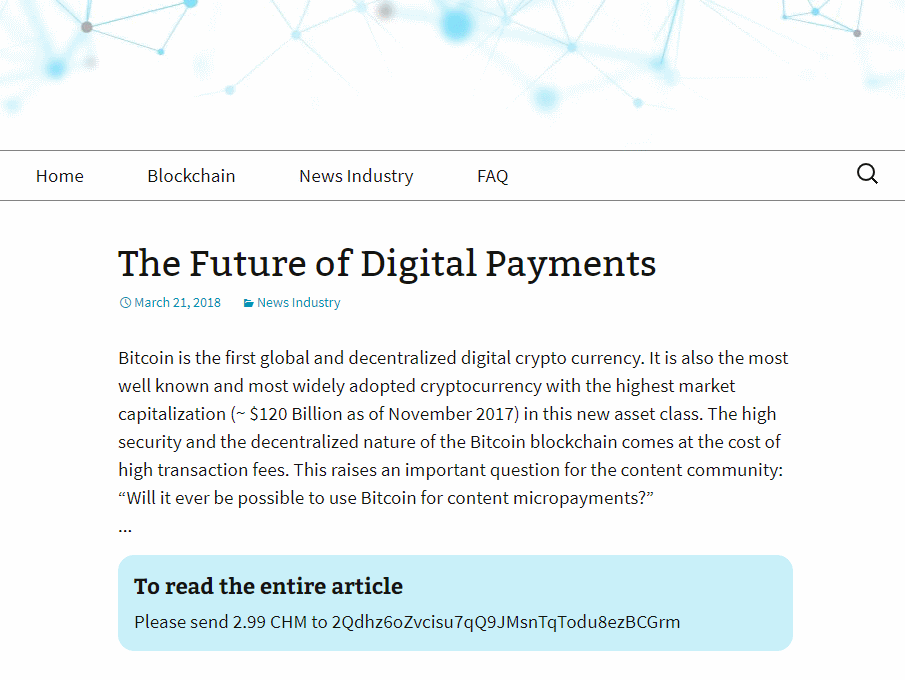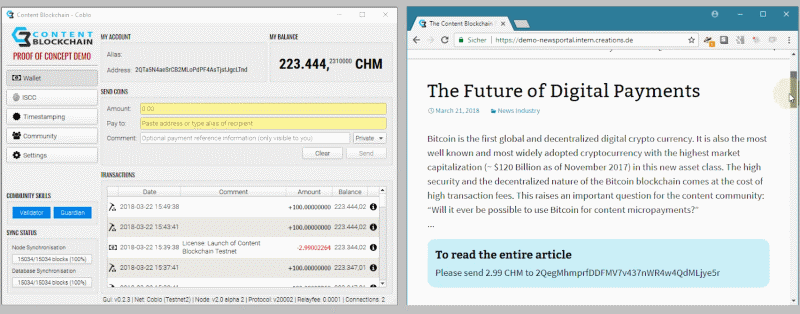Transactions on the Content Blockchain
Written by Sebastian Posth, 31 March 2018
Paying for Content on the Content Blockchain
In two previous posts “Content Identification on the Content Blockchain” and “What is a Smart License?”, the approach for content identification and license management on the Content Blockchain was described.
As a result, after registration of the content identifier and Smart License, it will be possible for apps to search the data on the Content Blockchain and locate entries for ISCC and Smart Licenses in the respective data streams. A Smart License is thus to be considered as an openly published content offering by a rights owner on a public blockchain.
In order to conclude a valid license agreement, the licensee needs to accept the offer by conducting the counter-performance the licensor has asked for. On the Content Blockchain, this is supposed to happen in one of the following ways:
- By chain payment;
- By chain attestation;
- By chain tokenization.
Please note that the mentioned methods – at this point – need to be seen as possible options yet to be developed for the Content Blockchain. They describe ways in which third parties can interact with the chain and adapt to the business models.
Chain Payment
Opting for a chain payment establishes that a license contract becomes effective between licensor and licensee when an on-chain payment of the previously set price from the licensee’s wallet-ID to the Wallet-ID of the licensor has been confirmed on the blockchain.
A Smart License that specifies chain payment as one of its possible transaction models must specify a price in one or multiple on-chain currencies (native or token) that are accepted as a payment that triggers the verifiable formation of a Smart License contract.
Chain Attestation
Opting for a chain attestation establishes that a license contract becomes effective between licensor and licensee when an on-chain attestation originating from the walled-ID of the licensor has been confirmed on the blockchain. An on-chain attestation is a manual or technically triggered confirmation of a valid transaction on the Content Blockchain. It has to include references to a Smart License and the wallet-ID of the licensee.
Chain attestation could be triggered manually through the Coblo wallet or automatically, e.g. after accepting a credit card or paypal payment transaction in FIAT currency or after accepting crypto currencies, like Bitcoin or Ethereum.
Chain Tokenization
A Smart License that specifies chain tokenization as one of its allowable transaction models must reference a specific token that secures the formation of a contract between the licensor and the token holder. This effectively means whoever holds such token is automatically a licensee of the Smart License that is bound to the token.
The Coblo WordPress Plugin
As a first example of a payment transaction on the Content Blockchain, the project has created a wordpress plug-in to accept chain payments for content behind a paywall.
Please note that the Coblo WordPress Plugin designed to accept chain payments for paywalled content does not involve Smart Licenses at this point. This method and technical solution serves a simple “pay-per-view” model, for which the user in principle does not need a license. Once the user pays, she is allowed to access the content. Further rights are not being transferred in this manner (because a “reading right” does not exist, nor does it need to be granted).
It is possible to test this payment option by using the Coblo wallet app on the following website:
Here, you can see a screencast of a payment transaction:
The video demonstrates a peer-to-peer chain payment to access content behind a paywall. The right to access the content is granted as a direct consequence of the chain payment to a specific address. The one-time payment addresses for the articles is individually created per article and per user accessing the websites. So anyone who visits the website will be provided with a different payment address, each payment address is unique to visitor and content. The payment addresses also serve as payment reference.
Please note that the connection between payment address and the content can only be made by the operator of the websites and the end-user. Thus, it is not possible for others than operator and user to extrapolate for what content the payment was made from the blockchain transaction details.
Distributing Content
Payment or attestation is a transaction that results in a claim of the licensee to gain access to the content.
This could happen through access to content on websites (see above) or via an access URL, that could be used by the licensee to retrive the licensed material, i.e. download of the digital content.
In the latter case, the access URL would deliver a WebPage or Api service that is able support features like:
- Authenticate a user by his/her Wallet-ID;
- Verify on the blockchain that the user has a valid license for the requested content;
- Deliver or stream the content to the user.
Ultimately the content delivery system behind the access URL is application specific. In the future the Content Blockchain Project might define a standard protocol for a content delivery system.


